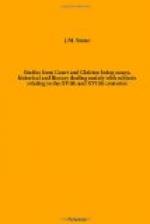VI. THE HARLEIAN COLLECTION OF MANUSCRIPTS
When Robert Harley laid the foundation of his magnificent library in t 7o5, so many collectors were already in the field that the prospect of getting together any large number of choice manuscripts did not seem promising. But contrary to expectation, this very fact proved fortunate, for whereas Cotton had built up his library, book by book, laboriously, Harley had the advantage of forming his, to a great extent, by the purchase of other well-known collections, either at the death of their original owners, or after the manuscripts had passed through successive hands. Of these larger acquisitions may be mentioned the library which had belonged to the famous antiquary, Sir Symonds D’Ewes, Cotton’s friend; the greater number of the Graevius MSS.; the 23 bulky volumes of the Baker collection; many of the papers originally belonging to Nicholas Charles, Lancaster Herald, which, at his death, Camden had purchased for 690 pounds, and the collection of Stow, the historian of London.
Charles’s library consisted chiefly of epitaphs, drawings of monuments and arms, and an historical catalogue of the officers of the College of Arms. Some of these are now at the Herald’s College, one of the manuscripts is in the Lansdowne collection, and the others were bought by Harley.
On Strype’s death in 1737, the majority of the papers, collected by Foxe the martyrologist, which had been in the annalist’s possession, also passed with others into Harley’s hands; they form vols. 416 to 428, and vol. 590 of this collection. Some of Foxe’s papers are in the Lansdowne library.
By means of great exertion and a lavish expenditure, Harley became within ten years the possessor of about 2500 old MSS., and in 1721 had collected 6000 volumes, 1400 charters, and 500 rolls, besides about 350,000 pamphlets. His entire library afterwards numbered over 20,000 volumes.
Robert Harley, afterwards Earl of Oxford, was descended from an ancient family, existing, it is pretended, in Shropshire at the time of the Norman Conquest, and closely allied to the French family of de Harlai. He was the eldest son of Sir Edward Harley, member for the county of Hereford, in the Parliament which restored Charles I I.; was born in 1661, rose to a high position in public affairs, and was created, by Queen Anne, a peer of the realm by the style and title of Baron Wigmore, in the county of Hereford, Earl of Oxford, and Mortimer.* Soon afterwards he was made Lord High Treasurer of Great Britain, and Prime Minister. He was twice married—first to Elizabeth, daughter of Thomas Foley of Whitley Court, Worcestershire, by whom he had three children—a son, Edward, who succeeded him, and two daughters. His second wife was Sarah, daughter of Simon Middleton, of Hurst Hill, Edmonton, who survived him some years.
* The Earldom of Mortimer was added, because, although Aubrey de Vere, twentieth Earl of Oxford had died without leaving male issue in 1702, it was necessary to guard against possible claimants among remote descendants of the de Veres.




